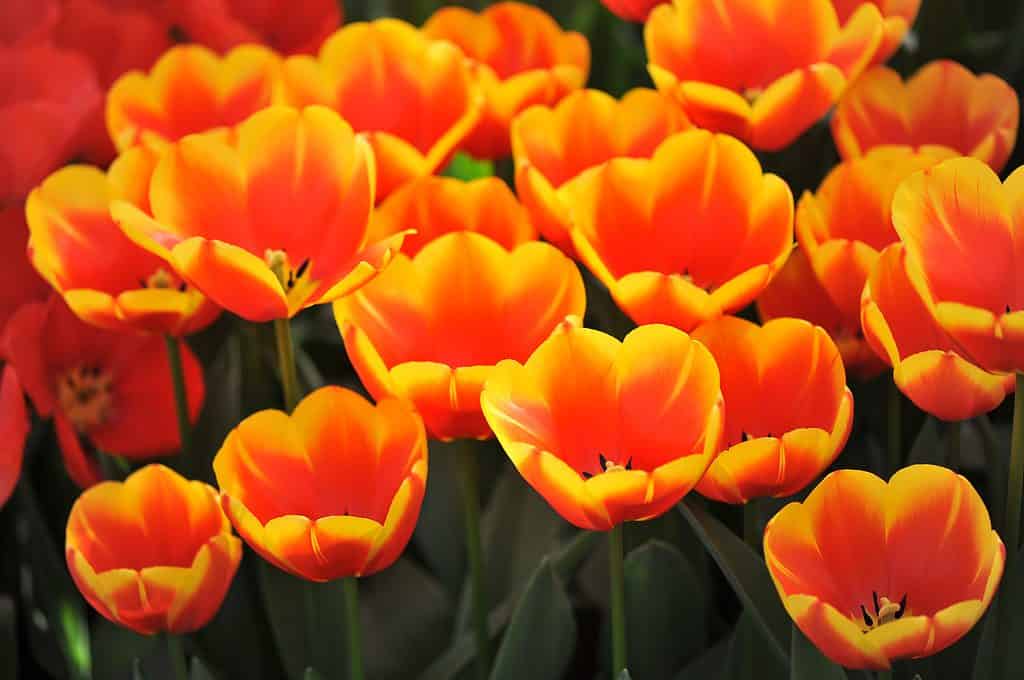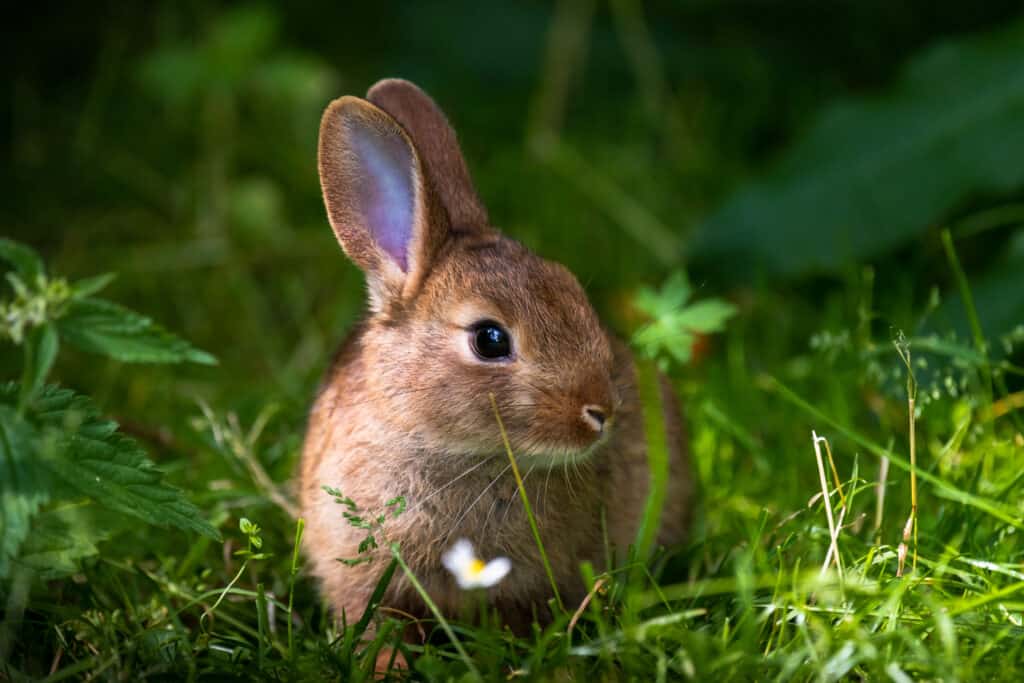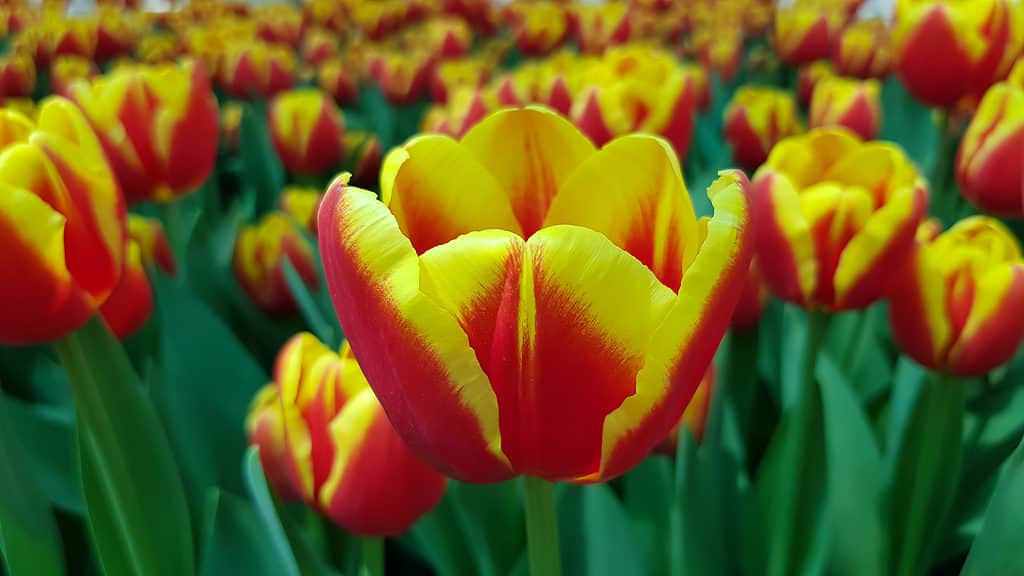While there are many gorgeous flowers to enjoy in the spring, the tulip really steals the show. These beauties can thrive in a wide swath of US climate zones, including the 5b-6b zones of Ohio.

Orange-red Greigii tulips
©Sergey V Kalyakin/Shutterstock.com
The Tulipa genus includes around 150 species with over 3,000 cultivars. They are divided into 15 different classifications based on shape, height, and when they bloom.
The sheer number of tulip types and varieties can make things very confusing for gardeners, so let’s clear things up. Here are some important things to remember to have a spectacular spring display of tulips in the Buckeye State.
| Tulip Facts | |
|---|---|
| Botanical name | Tulipa spp. |
| Common Name | Tulip |
| Plant Type | Perennial, bulb |
| Sunlight | Full |
| Soil | Rich, well-drained |
| Bloom Season | Spring |
| Toxicity | Toxic to both humans and pets |
Types
With the wide variety of tulips available, choosing the right ones for your garden or flower bed can be daunting. However, these three tulips can delight Ohioans every spring.
Fosteriana Tulips
Featuring some of the largest tulip blooms, Fosteriana tulips can really make Ohio gardens pop. They can also start your spring off on the right foot, as they are some of the earliest blooming tulips.
Also known as Emperor tulips due to the size of their bowl-shaped flowers, Fosteriana tulips can grow to heights of around 20 inches. They bloom in a dazzling array of colors, including white, cream, light and dark pink, yellow, orange, and red.
Fosteriana tulips are tough, hardy plants. They fare well in the unpredictable spring weather of Ohio, making them a popular choice for everyone from Clevelanders to Cincinnatians.

Yellow and white Fosteriana tulips
©Sergey V Kalyakin/Shutterstock.com
Darwin Hybrid Tulips
The Darwin hybrid tulip is among the most popular tulip cultivars due to its tall growth and brilliantly colored bulbs. It is a favorite both in gardens and in cut flower arrangements.
Darwin hybrids bloom mid-spring and come in a splendid array of vibrant colors, including yellow, red, pink, orange, white, and bi-color.
They are an excellent choice for Ohio gardens because they need the colder winters, and they can tolerate wild swings in spring temperatures. They can also grow in various environments, from partial shade to full sun.
One of the tallest-growing tulips, Darwin hybrids can reach heights of 28 inches or beyond.

Beautiful orange-yellow Darwin hybrid tulips
©Sergey V Kalyakin/Shutterstock.com
Greigii Tulips
Greigii tulips grow best in cooler climate zones, and Ohio is right in the sweet spot for these early-mid spring bloomers.
Greigiis are popular among Buckeye gardeners because they offer one of the longer tulip growing seasons, meaning you can enjoy the color through much of the spring.
Tulips in the Greigii group don’t grow as tall as other tulip types (topping out around 10 inches in height), but their blooms are actually quite large for their shorter stems. In fact, the Casa Grande (part of the Greigii group) features what is possibly the largest bloom of any tulip.
Greigii tulips feature colorful blooms in warm shades of orange, yellow, red, pink, and white.

Pink and white Greigii tulips
©Sergey V Kalyakin/Shutterstock.com
Planting Tips
Regardless of which tulip you choose, there are some best practices that will help you cultivate healthy, vibrant tulips that are sure to make your neighbors jealous.
Bulb Selection
Only purchase bulbs from a trusted supplier and inspect the bulbs before planting. If a bulb looks withered or moldy, discard it.
Healthy bulbs are beige-white with a paper-like outer jacket. Choose bulbs that are dry and firm, not soft or squishy. Look for bulbs with no spots, streaks, or cracks.
And go big. The bulb is where all the necessary nutrients are stored. Larger bulbs store more nutrients than smaller ones, which will show in the growing season. To put it simply, bigger bulbs yield bigger blooms.

Healthy tulip bulbs are large and free of discoloration.
©Natallia Ustsinava/Shutterstock.com
When to Plant
There are two types of flower bulbs: tender and hardy.
Tender bulbs cannot tolerate cold temperatures and must be kept indoors until the weather warms.
Hardy bulbs, on the other hand, don’t just tolerate the cold. They need it.
Tulip bulbs are hardy, meaning they require a period of cold weather to end their dormancy. Without this exposure to the frosty temperatures of winter, tulips will not grow and bloom in the spring.
It’s best to plant bulbs when the soil temperature is below 55°F. The ideal time for planting tulip bulbs in Ohio is in October or November. This will allow the bulbs to take root in the cool soil before the ground freezes.
Where to Plant
Tulips thrive in rich soil, with at least six hours of bright sunlight per day. Choose a spot that drains well. If the soil remains perpetually wet, it can lead to bulb rot.
Organic compost or synthetic fertilizer can also give your tulips a boost. When fertilizing, choose a slow-release fertilizer with a nutrient ratio of 9-9-6.
If you prefer an organic mix, you can use equal parts blood meal, greensand, and bone meal.
Plant the bulbs with the pointed side up and space them about 4 inches apart. In Ohio’s climate, it is recommended to plant bulbs 8-10 inches deep.
Perennial?
While tulips are perennials, many gardeners struggle when trying to coax the blooms to return year after year. One of the main reasons for this struggle is often placement.
Tulips (and all other bulbs) thrive when planted in their own area, separate from summer flowers. Flowers that grow throughout the summer usually require watering weekly, if not daily. If there are cold-hardy bulbs planted in that same area, those bulbs will become waterlogged with all that summer watering, which can cause them to rot.
If bulbs and summer flowers must share a space, it’s best to choose low-maintenance summer plants that require far less watering. That will give your bulbs the best chance to bloom again the following spring.
Many gardeners don’t have the space or resources to pull this off, so they don’t even attempt to grow tulips as perennials. Instead, they dig up the bulbs after the growing season and plant new bulbs in the fall. This is the surest way to guarantee a spectacular spring tulip display every year.

Darwin hybrid tulips can display various colors, including white and pink.
©Printemps PhotoArt/Shutterstock.com
When in Bloom
Tulips break through the ground’s surface in the spring, a season in Ohio that is anything but predictable. Sharp cold snaps can easily follow warm days. So what do you do if your tulips start poking through the ground ahead of a freeze? It may be hard to believe, but the best thing to do is nothing.
Remember, tulip bulbs are hardy. They can handle the wild swings of an Ohio springtime, even if that means a warm day followed by a nighttime frost. In fact, more damage can be done by covering these flowers with a sheet or blanket than by leaving them exposed to the cold.
When these very delicate-looking leaves and blooms appear to sprout “too soon” or the night is going to be “too cold,” many gardeners want to lend a helping hand. But in the case of tulips, the most helpful thing to do is to do nothing. Instead, let those hardy bulbs show you just how hardy they are!
Toxicity
Tulip bulbs contain alkaloid and glycoside compounds that are mildly toxic to humans and moderately toxic to pets.
Gardening gloves are highly recommended when handling bulbs or blooms to prevent “tulip fingers,” a skin rash well-known to tulip growers.
Common Pests
As with most flowers, there are some pests that can damage your tulips.
Aphids
These insects suck juices out of the plant. They can also carry the tulip-breaking virus (TBV).
TBV creates broken, striped patterns on the flowers that can actually appear quite beautiful. In fact, infected flowers were once high-sought after due to their unique appearance. This was stopped long ago, though, because of the destruction and spread of this virus.
Any tulip infected with TBV should be destroyed. Otherwise, the virus will spread to other flowers.
Aphids can be effectively controlled using insecticidal soap.

Aphids on a tulip
©Keattikorn/Shutterstock.com
Spider Mites
These pests also suck juices from tulip leaves. If the leaves show yellow or white specks, spider mites may be to blame.
Like aphids, insecticidal soap is effective at controlling spider mite infestations.
Wildlife Problems
Ohio is home to some wonderful wildlife, but some of them can cause significant problems for your tulips. For example, chipmunks and squirrels love to dig up tulip bulbs in the fall. As recommended above, planting at a deeper depth can deter these critters.
Rabbits, on the other hand, make their presence known in the spring. They munch on the tender shoots when tulips first break through the soil’s surface.

A wild orange rabbit in a fresh green forest.
©FullframeFactory/Shutterstock.com
Deer can also destroy your tulip garden. When tulips begin to grow, deer will pull them out of the ground, bulb and all.
You may consider using a commercially available repellent to prevent your tulips from becoming a rabbit and deer buffet. Be sure to read and follow the directions on the product’s label.
There are many reasons why tulips are the highlight of thousands of Ohio gardens every spring. These hardy flowers can handle the always-changing weather conditions with virtually no maintenance. And after a dreary winter, their springtime color will warm your heart.

Red and yellow Darwin hybrid tulips
©Printemps PhotoArt/Shutterstock.com
The photo featured at the top of this post is © iStock.com/kazakovmaksim
Thank you for reading! Have some feedback for us? Contact the AZ Animals editorial team.






